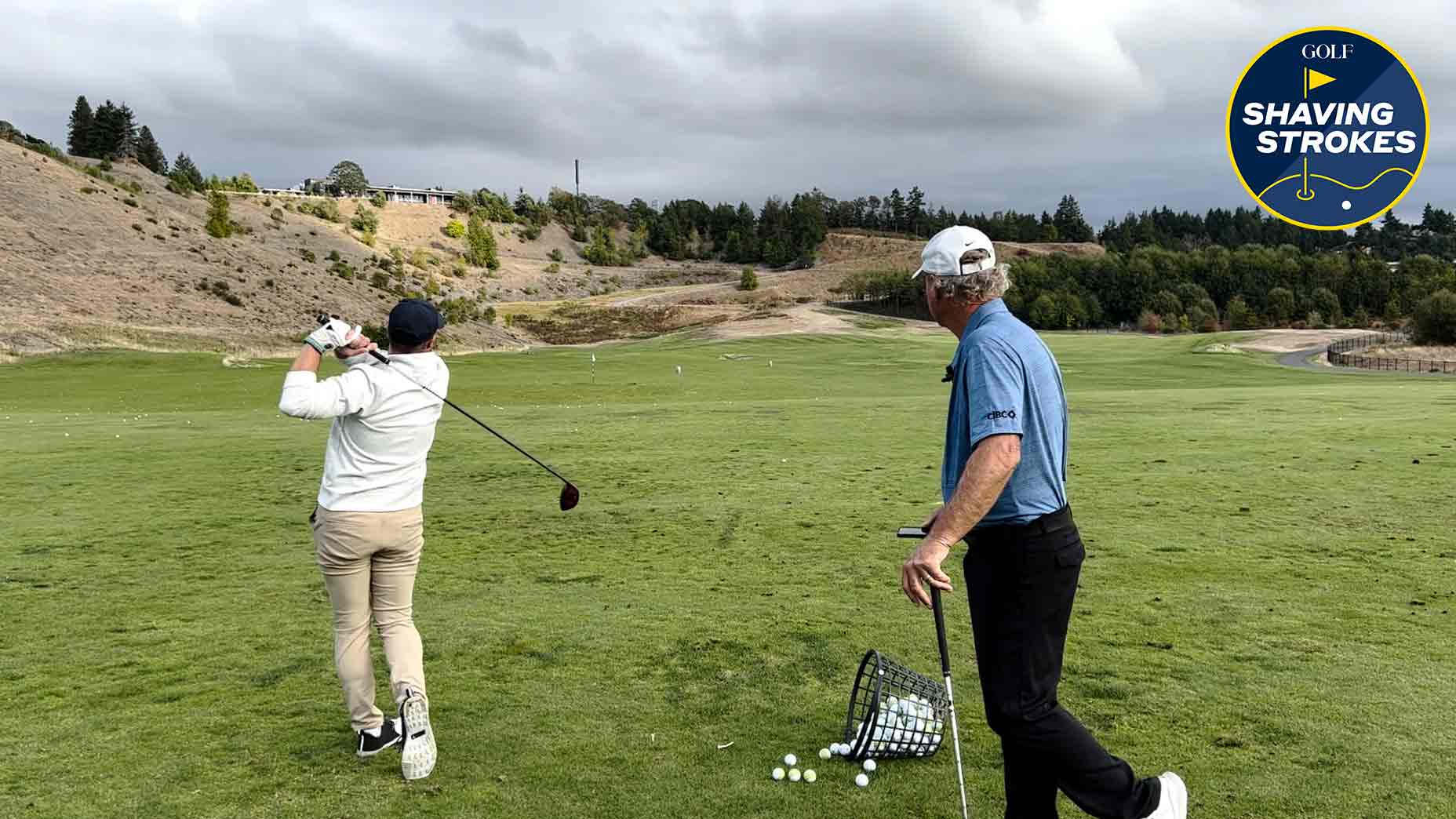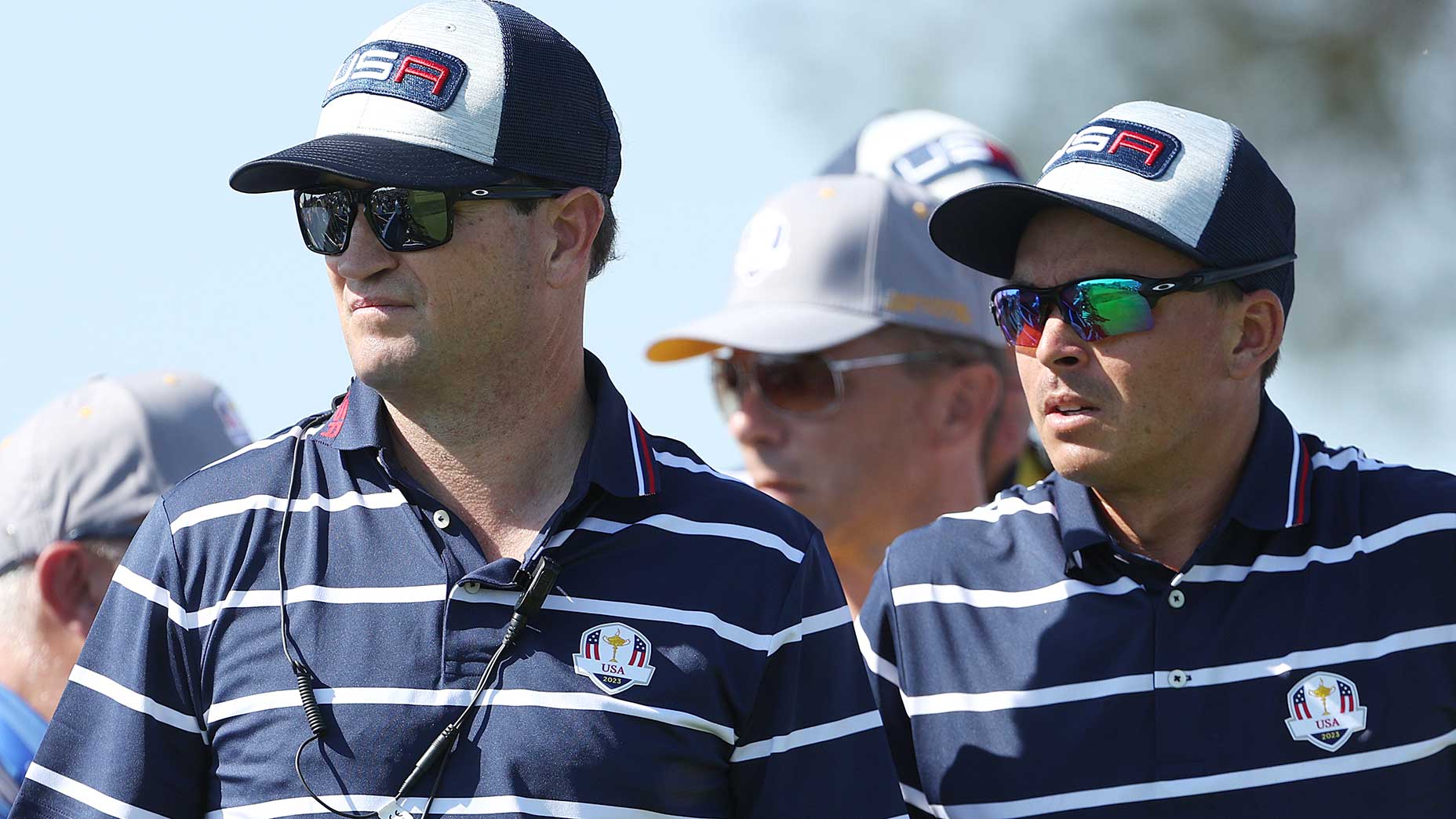
Welcome to Shaving Strokes, a new GOLF.com series in which we’re sharing improvements, learnings and takeaways from amateur golfers just like you — including some of the speed bumps and challenges they faced along the way.
Ever since I started my role as GOLF’s Instruction Editor, everyone had been telling me why data would become my best friend on my quest to break 80 — a goal I made for myself before my wife and I had our first baby.
As time dwindles before Baby Dimengo’s arrival (any day now!), sadly I’ve accepted that I won’t be breaking 80 beforehand. Preparing to be a first-time parent has taken priority over my golf scores.
Still, I can unquestionably confirm this: My ball-striking has never been better, and I can feel myself improving.
This is where that whole data thing comes into play.
Like many average golfers (I’m currently a 13-handicapper), I often went to the driving range without purpose. I’d just get a bucket of balls and start aimlessly banging them into the abyss, hoping that I’d magically discover an anti-slice potion.
Spoiler alert: I didn’t.
How launch-monitor data makes practice more efficient — and fun
One of my colleagues then came to me and asked if I had ever used a launch monitor. I hadn’t, and, candidly, I didn’t even know how one worked.
Long story short, I ended up getting introduced to a Full Swing launch monitor, which just so happens to be the same device used by some guy named Tiger Woods.
If the unit was good enough for a 15-time major winner, I figured it would likely also suffice for me.
And, well…wow. I’ve never had more fun practicing than I have when using a launch monitor. Helping me discover my “why,” the device has taken the guesswork out of improving my swing.
I now understand why I slice or hook a shot. Why I didn’t get the trajectory I wanted. Or why I was able to draw five-straight drives down the middle over 250 yards.
The device is compact and light enough to bring anywhere — like, say, the range. When I hit balls with buddies, having a launch monitor instantly flips on the competitive switch.
Like heavyweights vying for supremacy, we rotate through our shots, taking turns trying to one-up each other, and collecting instant feedback to reveal what we did well and what we could go better. Remember the game “H-O-R-S-E?” It’s like that, with each of us calling our intended shots before addressing the ball, then comparing our Carry, Spin Rate, Club Speed, Ball Speed, etc.
The Full Swing device records every swing, so you’re able to go back and analyze the good, bad and ugly, capturing those “aha moments” that every golfer hopes for.
How to use a launch monitor
After playing around with my new toy on my own, I was connected with GOLF Top 100 Teacher Brian Mogg to really dive into the details.
Every golfer obsesses over distance. But talking with Mogg helped me to understand which data from the launch monitor is actually most important — and how it can help you improve your ball-striking.
“Launch monitors have basically changed the game of golf,” Mogg said in the video above. “You can now, not just trust your eyes to see things, but use data to help us reflect ball flight, trajectory, speed, spin angles, launch rate.
“These launch monitors are fantastic at reinforcing just exactly what our eyes are seeing.”
When Mogg had me hit balls in front of him, I was a little timid. Naturally, I didn’t know what was “standard” or what was “good” — I just knew I started seeing information that allowed me to learn more quickly about my swing.
And while Mogg admits it’s fun to look at total yardage and clubhead speed, there are two data points that amateurs must really focus on.
“It’s important to [understand] launch angle and spin,” Mogg told me. “Launch angle with the driver should be in the 13-15-degree range, and if you’re getting it either too high or too low, you’re sacrificing distance. Spin rate with a driver should be in the 2,300-2,400 range. If it’s too high, the ball’s going to spin. If it’s too low, you’re not getting it airborne enough.”
Mogg then summed up the primary benefit of having a launch monitor.
“The data actually validates what we’re working on,” he said. “It gives me confidence as a teacher that we’re working on the right thing, and that the data and the numbers validate that this is what we should be doing.”
Moving away from driver, Mogg had me hit shots with my 7-iron.
Similar to using the launch monitor with my friends, he began challenging me like the aforementioned game of “H-O-R-S-E,” trying to get me to hit 170 yards with consistency.
With the pressure on: chunk…and chunk again.
In this instance, Mogg said I was just trying to put the club energy into the ball too early, and I was leaning too far forward on my toes.
But it was a key moment, because, since the Full Swing device films every shot, I can go back and analyze the data points later and unearth answers by rewatching mishits.
Fair enough, lesson learned. Now it’s time to move on.
“This is the fun part with a launch monitor,” Mogg said. “You get to work on your speeds, you get to work on your contact, and the feedback we get is really quick.”
I may have fallen short of my goal to break 80 by the end of September. And I still have plenty of work to do — particularly while putting — to improve my game.
But by using the Full Swing launch monitor these past couple of months and seeing exactly what types of tendencies I have with each shot, I now have the data to support my growth as a player — and I can hit more consistent shots because of it.
Want to share your firsthand experience for a chance to be featured in a future Shaving Strokes article? Share your details and progress by emailing me at nick.dimengo@golf.com. We’re all in this together, so let’s share our wins, our learnings and our frustrations to help one another improve!
All of our market picks are independently selected and curated by the editorial team.
If you buy a linked product,
GOLF.COM may earn a fee. Pricing may vary.
TheStack Swing Speed Trainer (Hardware + App Bundle)
$349
TheStack Hardware
5 milled Stack weights enable 30 weight combinations between 0g and 300g
Dual-purpose weight case / phone stand
Highly engineered training club – Adult (41.5″) or Junior (38.5″) version (see Fitting Juniors)
Speed radar not included. View all compatible devices here. We recommend the PRGR
TheStack App Training
2-year License included, accessible on iOS only.
Dynamic speed training formulated by Dr. Sasho MacKenzie
Guided workout timer for reps, sets, and rest intervals
Custom speed metrics to track your gains
Hands-free data entry using voice entry technology
Includes access to Stack Putting (Beta) – Learn more
Includes Single User License – Enables training and tracking for up to five local (i.e. family) users under one login.
Multi-user Coaches License license sold separately.
Access TheStack App from the App Store when your order arrives. Requires iOS 15.0 or later.
View Product










